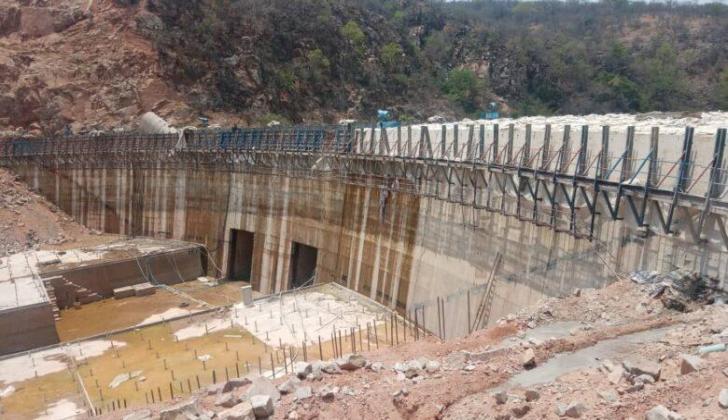News / National
'Gwayi-Shangani to transform Matabeleland region'
03 Dec 2024 at 09:09hrs |
0 Views

The near-completion of the Gwayi-Shangani Dam is poised to transform Matabeleland's agriculture, ensuring year-round crop production and bolstering food security, according to Pelandaba MP Joseph Tshuma.
Speaking in the National Assembly last week, Tshuma highlighted the importance of timely completion of the dam, which he believes will be a game-changer for the region's agricultural sector and Zimbabwe's broader economic growth.
"With its completion, we will have enough water for irrigation, and our farmers will be able to grow crops throughout the year," Tshuma said. "This is a crucial step for ensuring food security in the Matabeleland region."
The Gwayi-Shangani Dam will have a capacity of 650 million cubic metres of water, making it one of the largest inland dams in Zimbabwe, second only to Tugwi-Mukosi and Mutirikwi. The dam is expected to play a pivotal role in addressing the region's chronic water scarcity and vulnerability to recurrent droughts, which have hampered agricultural productivity for years.
Tshuma emphasized the significance of the dam, noting that its benefits would extend beyond Matabeleland, impacting the country's overall agricultural output:
"Out of 10 provinces, three are already food secure just by that one Gwayi-Shangani Dam," Tshuma added. "If we, as Members of Parliament, come together and ensure that this project is fully capacitated, it will be a miracle worker."
The Gwayi-Shangani Dam has been a long-standing project that dates back to 1912. Tshuma noted that despite previous setbacks, including stagnation during the first republic from 1980 to 2017, significant progress has been made in recent years. As of now, the dam is over 70% complete, with construction accelerating since 2018.
"The amazing green belt that is going to be created there will be something to be talked about the world over," Tshuma said. "From Gwayi-Shangani all the way up to Bulawayo and down to Matabeleland South, people will be able to irrigate their crops and engage in all-season farming."
The dam's completion will not only revolutionize agriculture in the region but also provide a much-needed solution to Bulawayo's water problems, improving the city's water supply.
Tshuma expressed optimism that the Gwayi-Shangani Dam will be a cornerstone of sustainable agricultural development in Matabeleland, helping to create a thriving green belt. With this infrastructure, he believes the region will be able to cultivate crops year-round, ensuring food security and creating a ripple effect of economic benefits for the local population.
The dam's completion is expected to improve irrigation capacity, bolster agricultural productivity, and contribute significantly to Zimbabwe's broader development goals. As the project nears its finish, Tshuma and other local leaders are hopeful that the dam will unlock new opportunities for economic growth and self-sufficiency in Matabeleland.
Speaking in the National Assembly last week, Tshuma highlighted the importance of timely completion of the dam, which he believes will be a game-changer for the region's agricultural sector and Zimbabwe's broader economic growth.
"With its completion, we will have enough water for irrigation, and our farmers will be able to grow crops throughout the year," Tshuma said. "This is a crucial step for ensuring food security in the Matabeleland region."
The Gwayi-Shangani Dam will have a capacity of 650 million cubic metres of water, making it one of the largest inland dams in Zimbabwe, second only to Tugwi-Mukosi and Mutirikwi. The dam is expected to play a pivotal role in addressing the region's chronic water scarcity and vulnerability to recurrent droughts, which have hampered agricultural productivity for years.
Tshuma emphasized the significance of the dam, noting that its benefits would extend beyond Matabeleland, impacting the country's overall agricultural output:
"Out of 10 provinces, three are already food secure just by that one Gwayi-Shangani Dam," Tshuma added. "If we, as Members of Parliament, come together and ensure that this project is fully capacitated, it will be a miracle worker."
The Gwayi-Shangani Dam has been a long-standing project that dates back to 1912. Tshuma noted that despite previous setbacks, including stagnation during the first republic from 1980 to 2017, significant progress has been made in recent years. As of now, the dam is over 70% complete, with construction accelerating since 2018.
"The amazing green belt that is going to be created there will be something to be talked about the world over," Tshuma said. "From Gwayi-Shangani all the way up to Bulawayo and down to Matabeleland South, people will be able to irrigate their crops and engage in all-season farming."
The dam's completion will not only revolutionize agriculture in the region but also provide a much-needed solution to Bulawayo's water problems, improving the city's water supply.
Tshuma expressed optimism that the Gwayi-Shangani Dam will be a cornerstone of sustainable agricultural development in Matabeleland, helping to create a thriving green belt. With this infrastructure, he believes the region will be able to cultivate crops year-round, ensuring food security and creating a ripple effect of economic benefits for the local population.
The dam's completion is expected to improve irrigation capacity, bolster agricultural productivity, and contribute significantly to Zimbabwe's broader development goals. As the project nears its finish, Tshuma and other local leaders are hopeful that the dam will unlock new opportunities for economic growth and self-sufficiency in Matabeleland.
Source - newsday
Join the discussion
Loading comments…

























